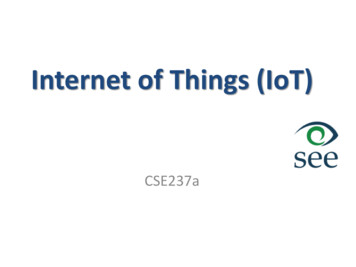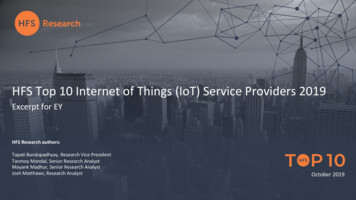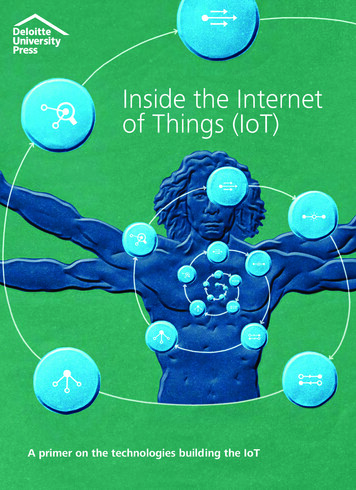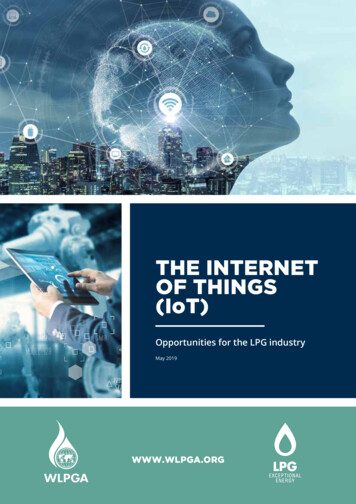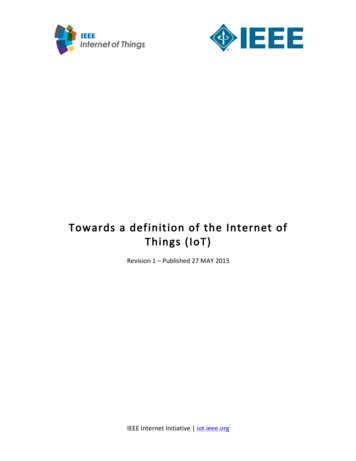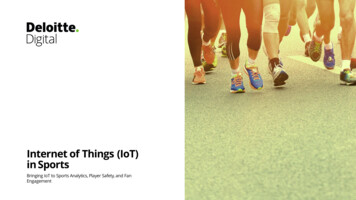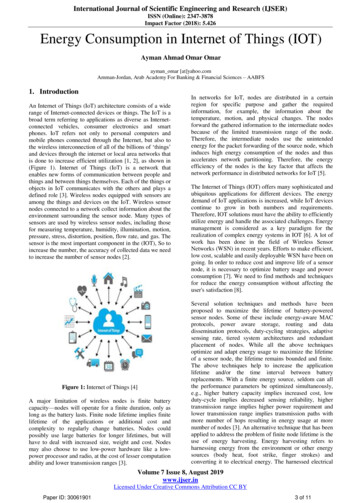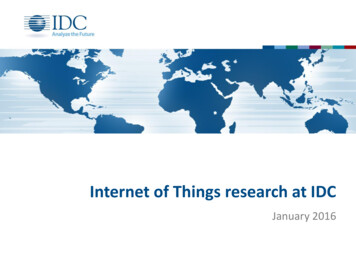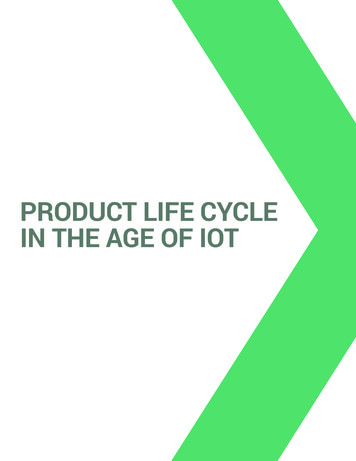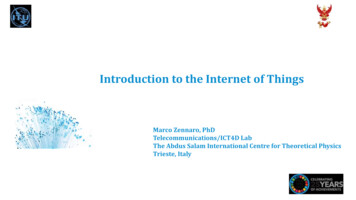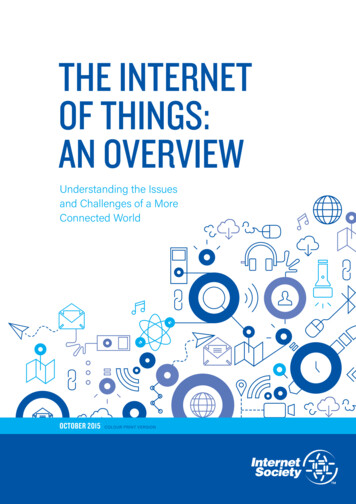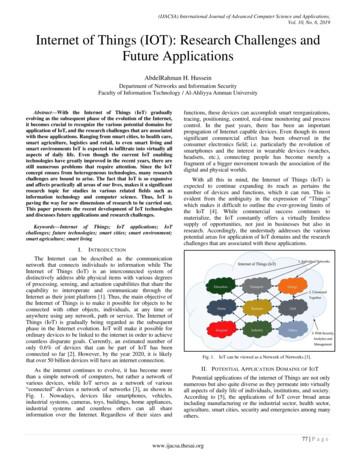
Transcription
(IJACSA) International Journal of Advanced Computer Science and Applications,Vol. 10, No. 6, 2019Internet of Things (IOT): Research Challenges andFuture ApplicationsAbdelRahman H. HusseinDepartment of Networks and Information SecurityFaculty of Information Technology / Al-Ahliyya Amman UniversityAbstract—With the Internet of Things (IoT) graduallyevolving as the subsequent phase of the evolution of the Internet,it becomes crucial to recognize the various potential domains forapplication of IoT, and the research challenges that are associatedwith these applications. Ranging from smart cities, to health care,smart agriculture, logistics and retail, to even smart living andsmart environments IoT is expected to infiltrate into virtually allaspects of daily life. Even though the current IoT enablingtechnologies have greatly improved in the recent years, there arestill numerous problems that require attention. Since the IoTconcept ensues from heterogeneous technologies, many researchchallenges are bound to arise. The fact that IoT is so expansiveand affects practically all areas of our lives, makes it a significantresearch topic for studies in various related fields such asinformation technology and computer science. Thus, IoT ispaving the way for new dimensions of research to be carried out.This paper presents the recent development of IoT technologiesand discusses future applications and research challenges.Keywords—Internet of Things; IoT applications; IoTchallenges; future technologies; smart cities; smart environment;smart agriculture; smart livingI.functions, these devices can accomplish smart reorganizations,tracing, positioning, control, real-time monitoring and processcontrol. In the past years, there has been an importantpropagation of Internet capable devices. Even though its mostsignificant commercial effect has been observed in theconsumer electronics field; i.e. particularly the revolution ofsmartphones and the interest in wearable devices (watches,headsets, etc.), connecting people has become merely afragment of a bigger movement towards the association of thedigital and physical worlds.With all this in mind, the Internet of Things (IoT) isexpected to continue expanding its reach as pertains thenumber of devices and functions, which it can run. This isevident from the ambiguity in the expression of “Things”which makes it difficult to outline the ever-growing limits ofthe IoT [4]. While commercial success continues tomaterialize, the IoT constantly offers a virtually limitlesssupply of opportunities, not just in businesses but also inresearch. Accordingly, the understudy addresses the variouspotential areas for application of IoT domains and the researchchallenges that are associated with these applications.I NTRODUCTIONThe Internet can be described as the communicationnetwork that connects individuals to information while TheInternet of Things (IoT) is an interconnected system ofdistinctively address able physical items with various degreesof processing, sensing, and actuation capabilities that share thecapability to interoperate and communicate through theInternet as their joint platform [1]. Thus, the main objective ofthe Internet of Things is to make it possible for objects to beconnected with other objects, individuals, at any time oranywhere using any network, path or service. The Internet ofThings (IoT) is gradually being regarded as the subsequentphase in the Internet evolution. IoT will make it possible forordinary devices to be linked to the internet in order to achievecountless disparate goals. Currently, an estimated number ofonly 0.6% of devices that can be part of IoT has beenconnected so far [2]. However, by the year 2020, it is likelythat over 50 billion devices will have an internet connection.As the internet continues to evolve, it has become morethan a simple network of computers, but rather a network ofvarious devices, while IoT serves as a network of various“connected” devices a network of networks [3], as shown inFig. 1. Nowadays, devices like smartphones, vehicles,industrial systems, cameras, toys, buildings, home appliances,industrial systems and countless others can all shareinformation over the Internet. Regardless of their sizes andFig. 1.IoT can be viewed as a Network of Networks [3].II. P OTENTIAL A PPLICATION D OMAINS OF I O TPotential applications of the internet of Things are not onlynumerous but also quite diverse as they permeate into virtuallyall aspects of daily life of individuals, institutions, and society.According to [5], the applications of IoT cover broad areasincluding manufacturing or the industrial sector, health sector,agriculture, smart cities, security and emergencies among manyothers.77 P a g ewww.ijacsa.thesai.org
(IJACSA) International Journal of Advanced Computer Science and Applications,Vol. 10, No. 6, 2019A. Smart CitiesAccording to [6], the IoT plays a crucial role in improvingthe smartness of cities and enhancing general infrastructure.Some of IoT application areas in creating smart cities include;intelligent transportation systems [7], smart building, trafficcongestion [7, 8] waste management [9], smart lighting, smartparking, and urban maps. This may include differentfunctionalities such as; monitoring available parking spaceswithin the city, monitoring vibrations as well as materialconditions of bridges and buildings, putting in place soundmonitoring devices in sensitive parts of cities, as well asmonitoring the levels of pedestrians and vehicles. ArtificialIntelligence (AI) enabled IoT can be utilized to monitor,control and reduce traffic congestions in Smart Cities [6].Moreover, IoT allows installation of intelligent and weatheradaptive street lighting and detection waste and wastecontainers by keeping tabs of trash collection schedules.Intelligent highways can provide warning messages andimportant information, such as access to diversions dependingon the climatic conditions or unexpected occurrences liketraffic jams and accidents.can be applied to outpatient and inpatient patients, dentalBluetooth devices and toothbrushes that can give informationafter they are used and patient’s surveillance. Other elements ofIoT in this capacity include; RFID, Bluetooth, and Wi-Fiamong others. These will greatly enhance measurement andmonitoring techniques of critical functions like blood pressure,temperature, heart rate, blood glucose, cholesterol levels, andmany others.Application of IoT to achieve smart cities would requireusing radio frequency identification and sensors. Some of thealready developed applications in this area are the Aware homeand the Smart Santander functionalities. In the United States,some major cities like Boston have plans on how to implementthe Internet of Things in most of their systems ranging fromtheir parking meters, streetlights, sprinkler systems, andsewage grates are all scheduled to be interlinked and connectedto the internet. Such applications will offer significant breakthroughs in terms of saving money and energy.C. Smart Agriculture and Water ManagementAccording to [11], the IoT has the capacity to strengthenand enhance the agriculture sector through examining soilmoisture and in the case of vineyards, monitoring the trunkdiameter. IoT would allow to control and preserve the quantityof vitamins found in agricultural products, and regulatemicroclimate conditions in order to make the most of theproduction of vegetables and fruits and their quality.Furthermore, studying weather conditions allows forecasting ofice information, drought, wind changes, rain or snow, thuscontrolling temperature and humidity levels to prevent fungusas well as other microbial contaminants.B. HealthcareMost healthcare systems in many countries are inefficient,slow and inevitably prone to error. This can easily be changedsince the healthcare sector relies on numerous activities anddevices that can be automated and enhanced throughtechnology. Additional technology that can facilitate variousoperations like report sharing to multiple individuals andlocations, record keeping and dispensing medications would goa long way in changing the healthcare sector [10].A lot of benefits that IoT application offers in the healthcare sector is most categorized into tracking of patients, staff,and objects, identifying, as well as authenticating, individuals,and the automatic gathering of data and sensing. Hospitalworkflow can be significantly improved once patients flow istracked. Additionally, authentication and identification reduceincidents that may be harmful to patients, record maintenanceand fewer cases of mismatching infants. In addition, automaticdata collection and transmission is vital in process automation,reduction of form processing timelines, automated procedureauditing as well as medical inventory management. Sensordevices allow functions centered on patients, particularly, indiagnosing conditions and availing real-time information aboutpatients’ health indicators [6].The applications of Internet of Things (IoT) and Internet ofEverything (IoE) are further being extended through thematerialization of the Internet of Nano-things (IoNT) [3]. Thenotion of IoNT, as the name implies, is being engineered byintegrating Nano-sensors in diverse objects (things) using Nanonetworks. Medical application, as shown in Fig. 2, is one of themajor focuses of IoNT implementations. Application of IoNTin human body, for treatment purposes, facilitates access todata from in situ parts of the body which were hitherto inaccessible to sense from or by using those medical instrumentsincorporated with bulky sensor size. Thus, IoNT will enablenew medical data to be collected, leading to new discoveriesand better diagnostics.When it comes to cattle, IoT can assist in identifyinganimals that graze in open locations, detecting detrimentalgases from animal excrements in farms, as well as controllinggrowth conditions in offspring to enhance chances of healthand survival and so on. Moreover, through IoT application inagriculture, a lot of wastage and spoilage can be avoidedthrough proper monitoring techniques and management of theentire agriculture field. It also leads to better electricity andwater control.Application domains in this sector include; being able tomonitor a patient’s compliance with prescriptions, telemedicinesolutions, and alerts for patients’ well-being. Thereby, sensorsFig. 2. The Internet of Nano-Things [3].78 P a g ewww.ijacsa.thesai.org
(IJACSA) International Journal of Advanced Computer Science and Applications,Vol. 10, No. 6, 2019As [11] explain, in water management, the role of IoTincludes studying water suitability in seas and rivers for bothdrinking and agriculture use, detecting pressure variations inpipes, and liquid presence outside tanks as well as monitoringlevels of water variation in dams, rivers and reservoirs. TheseIoT applications utilize Wireless sensor networks. Examples ofexisting IoT applications in this domain include; SiSviA,GBROOS, and SEMAT.D. Retail and LogisticsExecuting the IoT in Supply Chain or retail Managementhas many benefits. Some include; observing storage conditionsthroughout the supply chain, product tracking to enable traceability purposes, payment processing depending on the locationor activity period in public transport, theme parks, gyms, andothers. Inside the retail premises, IoT can be applied to variousapplications such as direction in the shop based on apreselected list, fast payment processes like automaticallychecking out with the aid of biometrics, detecting potentialallergen products and controlling the rotation of products onshelves and warehouses in order to automate restockingprocedures [12].The IoT elements mostly used in this setting include;wireless sensor networks and radio frequency identification. Inretail, there is a current use of SAP (Systems Applications andProducts), while in logistics numerous examples includequality consignment conditions, item location, detectingstorage incompatibility issues, fleet tracking among others. Inthe industry domain, IoT helps in detecting levels of gas andleakages within the industry and its environs, keeping track oftoxic gases as well as the oxygen levels within the confines ofchemical plants to ensure the safety of goods and workers andobserving levels of oil, gases and water in cisterns and storagetanks. Application of IoT also assists in maintenance and repairbecause systems can be put in place to predict equipmentmalfunctions and at the same automatically schedule periodicmaintenance services before there is a failure in the equipment.This can be achieved through the installation of sensors insideequipment or machinery to monitor their functionality andoccasionally send reports.E. Smart LivingIn this domain, IoT can be applied in remote controldevices whereby one can remotely switch appliances on andoff hence preventing accidents as well as saving energy [1, 3].Other smart home appliances include refrigerators fitted withLCD (Liquid Crystal Display) screens, enabling one to knowwhat is available inside, what has over stayed and is almostexpiring as well as what needs to be restocked. Thisinformation can also be linked to a smartphone applicationenabling one to access it when outside the house and thereforebuy what is needed. Furthermore, washing machines can allowone to remotely monitor laundry. In addition, a wide range ofkitchen devices can be interfaced through a smartphone, hencemaking it possible to adjust temperature, like in the case of anoven. Some ovens which have a self-cleaning feature can beeasily monitored as well. In terms of safety in the home, IoTcan be applied through alarm systems and cameras can beinstalled to monitor and detect window or door openings hencepreventing intruders [3].F. Smart EnvironmentThe environment has a vital role within all aspects of life,from people, to animals, birds and also plants, are all affectedby an unhealthy environment i
Things (IoT) is gradually being regarded as the subsequent phase in the Internet evolution. IoT will make it possible for ordinary devices to be linked to the internet in order to achieve countless disparate goals. Currently, an estimated number of only 0.6% of devices that can be part of IoT has been connected so far [2]. However, by the year 2020, it is likely that over 50 billion devices .
